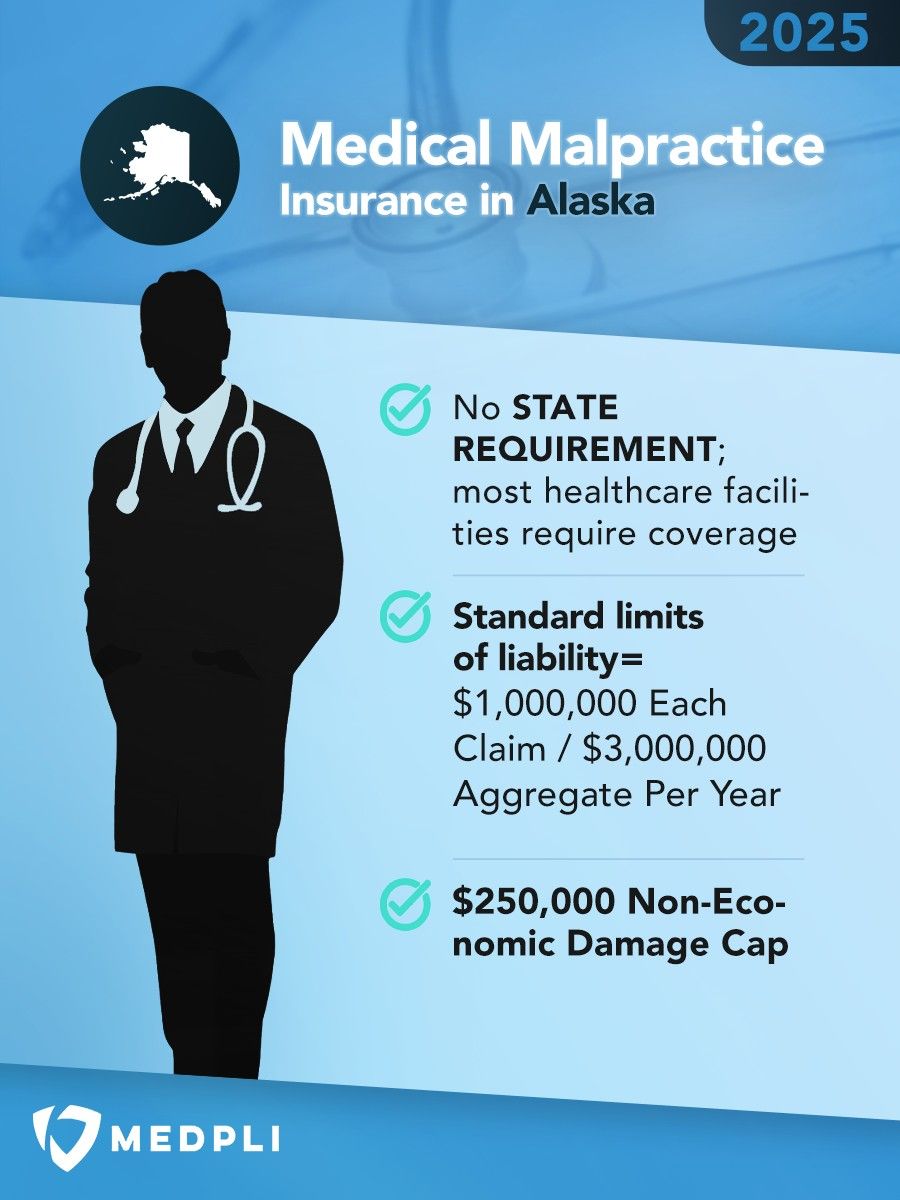Top 5 Medical Malpractice Insurance Carriers in Alaska
We recommend carriers with an AM Best “A” or higher rating. An A-rating indicates financial strength, long-term solvency, and an established history of protecting Alaska physicians.

2025 Alaska Malpractice Insurance Rates by Specialty
These rate estimates are for informational purposes only and are based on the AK standard limits of $1,000,000 for each claim / $3,000,000 aggregate per year in coverage.
Quotes require a completed application and underwriter approval. Contact us for a custom estimate if you don’t see your specialty.
| Specialty | 2025 Annual Premium |
2025 Tail Premium |
|---|---|---|
| Anesthesiology | $12,000 | $24,000 |
| Cardiovascular Disease– Minor Surgery | $14,000 | $28,000 |
| Dermatology– No Surgery | $5,000 | $10,000 |
| Emergency Medicine | $20,000 | $40,000 |
| Family Practice– No Surgery | $9,000 | $18,000 |
| Gastroenterology– No Surgery | $10,000 | $20,000 |
| General Practice– No Surgery | $9,000 | $18,000 |
| General Surgery | $30,000 | $60,000 |
| Internal Medicine– No Surgery | $9,000 | $18,000 |
| Neurology– No Surgery | $10,000 | $20,000 |
| Obstetrics and Gynecology– Major Surgery | $45,000 | $90,000 |
| Occupational Medicine | $5,000 | $10,000 |
| Ophthalmology– No Surgery | $5,000 | $10,000 |
| Orthopedic Surgery– No Spine | $30,000 | $60,000 |
| Pathology– No Surgery | $7,000 | $14,000 |
| Pediatrics– No Surgery | $9,000 | $18,000 |
| Pulmonary Disease– No Surgery | $12,000 | $24,000 |
| Psychiatry | $5,000 | $10,000 |
| Radiology – Diagnostic | $15,000 | $30,000 |
Alaska Medical Malpractice Payouts From 2015-2024
Rising Home Insurance Rates: The Hidden Impact on Medical Malpractice Costs
When wildfires, coastal storms, and other severe weather events strike Alaska, the consequences go beyond physical damage. Extreme weather pushes insurance costs higher across the state. As extreme weather grows more frequent, insurers are forced to raise rates to keep pace with rising risks.
While homeowners insurance in Alaska remains below the national average, insurance rates in Alaska are steadily rising. And it’s not just Alaska homeowners who are affected; businesses, including medical professionals, are feeling the pressure, too.
Why Are Insurance Rates Rising?
How the Cost of Alaska’s Medical Malpractice Insurance Is Affected
Reinsurance providers now charge higher premiums and impose stricter payout conditions. In response, primary insurers, including those offering medical malpractice coverage across the US, have increased premiums. While malpractice premiums are increasing at a slower rate in Alaska than nationwide, Alaska is not immune. Alaskan physicians should prepare for premium increases as extreme weather events become more frequent.
Severe weather isn’t just a coastal problem—it’s impacting insurance costs for everyone.
Types of Professional Liability Insurance for Alaska Physicians
Types of Professional Liability Insurance for Alaska Physicians
Doctors in Alaska can choose between these two primary types of medical malpractice insurance:

- This policy covers incidents that occurred during the policy period if the claim is filed while the policy is active. However, if a claim is filed after the policy ends, it is NOT covered.
- Typically, it offers lower premiums at the start of the policy, but rates increase yearly as the policy matures.
- Physicians must obtain tail insurance coverage when a claims-made policy ends to ensure protection against future claims related to incidents that occurred during the policy period. Tail insurance premiums require a one-time cash payment equal to approximately 200% of the claims-made policy’s annual premium.
- Physicians may purchase nose coverage, or prior acts coverage, instead of tail coverage, which is more comprehensive and expensive. Nose coverage can be purchased through a new carrier to protect physicians from claims before the new policy, back to a specified date.

- Provides coverage for incidents that occurred during the policy period, regardless of when a claim is reported to the carrier.
- Typically, it offers more costly premiums at the start of the policy, but the rate stays constant throughout the policy’s duration.
- Physicians do not need tail coverage when an occurrence policy ends.
In 2024, Alaska physicians were held liable for 14 medical malpractice payouts.
- Average Payout: $252,410
- Total Payout: $3,533,750
(Source: National Practitioner Data Bank)
Alaska Medical Malpractice: Key Damage Caps and Legal Rules Explained
Title 9 of Alaska’s Code of Civil Procedure limits noneconomic damages such as pain and suffering, physical impairment, and loss of enjoyment of life to $250,000 per claim.
Key Rules & Considerations
- No Cap on Economic Damages: Alaska does not limit the amount a jury can award for economic damages, including medical expenses, lost income, and other financial losses.
- Wrongful Death or Severe Injury: If malpractice results in death or permanent injury that is more than 70% disabling, the cap on noneconomic damages increases to $400,000 per claim.
- Reckless or Intentional Misconduct: Damage caps do not apply if the provider’s actions are deemed reckless or intentional misconduct.
- Burden of Proof: Plaintiffs must prove that the provider breached the standard of care and that the breach caused the injury.
- Expert Panel: Within 20 days after the defendant files an answer, the court must appoint a three-member expert panel.
- Several Liability: Alaska follows a severe liability rule, meaning each defendant is only responsible for the portion of damages attributed to them. This protects physicians from liability for the full award if other parties share fault.
Alaska’s Statute of Limitations for Medical Negligence Claims
Alaska law requires malpractice actions to be filed within two years of the date of discovery of injury.
Notable Exceptions
- Statue of Repose: A malpractice lawsuit can’t be filed more than ten years after the date of the alleged malpractice, regardless of when the injury was discovered.
- Misrepresentation or Fraudulent Concealment: The statute does not apply if misrepresentation or intentional concealment prevents the plaintiff from discovering the injury.
- Foreign Object: The statute is tolled if a foreign object was carelessly left inside the plaintiff’s body.
- Disabilities of Minority & Incompetency: The statute of limitations is tolled if an action is brought against a minor or a person is deemed incompetent due to mental illness or disability. The two-year statute of limitations begins once the minor turns 18 or the disability is removed.
Key Malpractice Laws in Alaska
- 1991: The Discovery Rule is enacted, which tolls the two-year statute of limitations until injury is discovered.
- 1997: Alaska’s Tort Reform Act established a non-economic damage cap, a ten-year statute of repose, and several liability provisions.
- 2024: Burden of proof established. The plaintiff must prove that the physician’s negligence or misconduct more likely than not led to injury.
Alaska’s malpractice laws aim to balance patient and physician rights while addressing the steady increase in malpractice cases. Historically, tort reform in Alaska has provided increased protection for physicians against excessive payouts and unfounded malpractice cases.
Why Alaska Doctors Partner with MEDPLI
We exclusively broker medical malpractice insurance, focusing daily on making the professional liability process less burdensome and expensive for doctors.
With MEDPLI, Alaska physicians:
MEDPLI helps doctors in every specialty.
Whether you’re a plastic surgeon in Anchorage or a general surgeon in Fairbanks, MEDPLI will provide you with premier coverage at a competitive rate.
Call 800-969-1339 or Request a Quote.
About the Author
Max Schloemann is a medical malpractice insurance broker helping physicians and surgeons secure Medical Professional Liability coverage. A Magna Cum Laude graduate of Southern Illinois University’s College of Business, he was named Outstanding Management Senior.
Max began his career in 2008 at an industry-leading firm and founded MEDPLI in 2017 to guide private practice doctors and physicians in transition through the complexities of malpractice insurance.
Outside of work, Max, his wife Kristen (a Physician Assistant), and their four kids enjoy the outdoors and attending the kids’ sporting events. For malpractice insurance questions, you can contact Max here.
Latest from the Medical Malpractice Insurance Blog
Read 2026 Washington medical malpractice insurance rates by specialty, carriers, payouts, and regulations. Get your custom MEDPLI quote today.
See 2026 Massachusetts medical malpractice insurance rates by specialty, carriers, payouts, and regulations. Get your custom MEDPLI quote today.
GUIDE: Overview of Arizona medical malpractice insurance rates by specialty, top carriers, payout statistics & state regulations. Get a custom quote here.
See 2026 Virginia’s medical malpractice insurance guide for the latest rates by specialty, top carriers, payouts & state regulations. Get your quote today.







